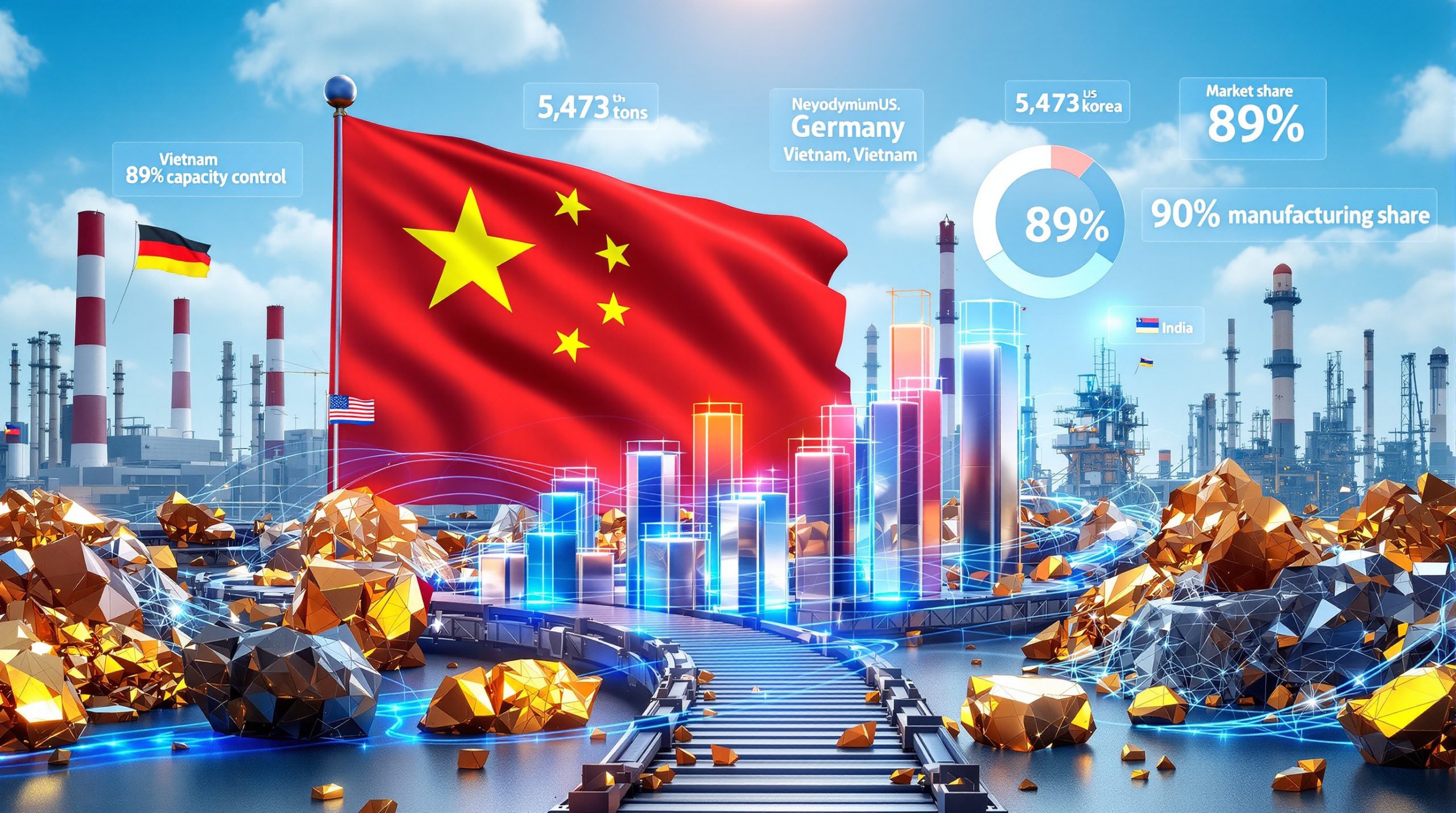The global minerals landscape faces unprecedented challenges as strategic rare earth supply chains encounter disruption from geopolitical tensions. The Saudi rare earths refinery project emerges as a transformative initiative designed to address these vulnerabilities through strategic partnerships. Furthermore, traditional processing hubs concentrated in single nations create bottlenecks that ripple through defense technologies, clean energy systems, and advanced manufacturing sectors.
Strategic Geographic Advantages in Middle Eastern Rare Earth Processing
The Kingdom's entry into rare earth processing leverages several competitive advantages that distinguish it from established global hubs. However, energy-intensive separation processes benefit significantly from the region's abundant and competitively priced energy resources, creating cost differentials that could reshape processing economics globally.
Transportation logistics present another strategic advantage, with Saudi Arabian facilities positioned to serve Asian, European, and American markets through established shipping networks. In addition, the Red Sea and Persian Gulf provide direct access to major consuming regions, potentially reducing supply chain complexity compared to traditional routing patterns.
Infrastructure Development and Economic Positioning
Saudi Arabia's Vision 2030 economic diversification program positions mining as a fundamental pillar for reducing oil dependency. This strategic commitment provides institutional support and regulatory frameworks designed to attract international partnerships in critical minerals processing, as outlined in their critical minerals strategy.
The regulatory environment offers streamlined permitting processes for strategic industrial projects, combined with investment incentives targeting technology transfer partnerships. Consequently, these policy frameworks create conditions favourable to complex industrial development requiring substantial capital investment and technical expertise.
Table: Competitive Processing Advantages
| Factor | Saudi Arabia | Traditional Hubs | Strategic Benefit |
|---|---|---|---|
| Energy Costs | Low (subsidised) | Variable (market-based) | 15-30% processing cost reduction |
| Regulatory Environment | Streamlined for strategic projects | Complex, varied | Faster project approval |
| Geographic Position | Central to major markets | Concentrated regions | Reduced transportation costs |
| Government Support | Vision 2030 backing | Market-driven | Long-term policy stability |
Resource base assessments indicate potential for both light and heavy rare earth processing capabilities, though specific geological characteristics of Saudi deposits remain under evaluation. For instance, the flexibility to process materials from multiple sources, including international feedstock, reduces dependence on domestic resource constraints while building processing expertise.
Pentagon Partnership Restructuring Supply Chain Dependencies
The Department of Defense investment in MP Materials represents a strategic shift toward supply chain resilience through diversified processing capabilities. Moreover, Washington's stake as the largest shareholder creates unprecedented alignment between private enterprise and national security objectives in critical minerals, aligning with broader defence material strategy frameworks.
Joint Venture Structure and Strategic Implications
The 49% combined stake held by MP Materials and the Pentagon, with Maaden controlling 51%, establishes a governance model balancing American strategic interests with Saudi sovereign control. This structure enables technology transfer while maintaining host nation ownership requirements.
According to Mining Weekly, "Strategic minerals security requires processing capabilities outside traditional supply chains dominated by single nations, particularly when those nations have demonstrated willingness to restrict exports during geopolitical tensions."
Defense Department funding mechanisms extend beyond traditional procurement models, incorporating industrial base development as a national security priority. Furthermore, this approach recognises that processing infrastructure, not just raw materials, determines strategic mineral access during supply disruptions.
Risk distribution analysis reveals how diversified processing reduces vulnerability to export restrictions or facility disruptions. Historical precedents demonstrate how concentrated processing creates chokepoints that can halt entire technology manufacturing sectors within weeks.
Scenario Modelling: Supply Chain Outcomes
| Scenario | Current State | With Saudi Facility | Risk Reduction |
|---|---|---|---|
| Export Restrictions | 90% disruption | 40% disruption | 50% improvement |
| Processing Facility Damage | 80% capacity loss | 35% capacity loss | 45% improvement |
| Geopolitical Tensions | Complete cutoff risk | Partial supply maintained | Strategic continuity |
Technical Processing Complexities and Innovation Requirements
Rare earth element separation presents unique metallurgical challenges that have historically concentrated processing in specialised facilities. However, the Saudi rare earths refinery project must overcome technical hurdles involving 17 different metallic elements with nearly identical atomic properties, requiring precise sequential separation processes.
Heavy Rare Earth Processing Challenges
Heavy rare earth elements, particularly dysprosium and terbium, present the most complex separation challenges due to their similar chemical properties. These elements are critical for permanent magnets in electric vehicles, wind turbines, and military applications, yet represent the most technically demanding processing requirements.
Step-by-Step Processing Requirements:
- Ore Preparation: Physical separation of rare earth concentrates from gangue minerals
- Chemical Treatment: Acid leaching to dissolve rare earth compounds into solution
- Sequential Separation: Solvent extraction using specialised organic compounds
- Individual Element Isolation: Progressive separation of each element in specific order
- Oxide Production: Converting separated elements into commercially viable oxide forms
- Quality Control: Meeting defence-grade specifications for purity levels
Environmental management systems must address radioactive waste streams naturally occurring in rare earth ores. Processing facilities require sophisticated waste management solutions and long-term disposal strategies for thorium and uranium byproducts.
The technical constraint preventing selective processing means facilities cannot economically extract only desired elements. Consequently, complete processing of all rare earth elements in a deposit becomes necessary, requiring market strategies for less valuable elements alongside strategic ones.
Technology Adaptation and Workforce Development
Ore characteristics vary significantly between geographical regions, requiring adaptation of processing parameters for Saudi feedstock. Chemical compositions, mineral associations, and trace element content influence separation efficiency and processing costs.
Processing equipment modifications involve adjusting solvent extraction circuits, residence times, and chemical reagent ratios to optimise recovery rates. These adaptations require extensive pilot testing and process optimisation before commercial production begins.
Workforce development programmes must transfer specialised knowledge in rare earth chemistry, equipment operation, and quality control procedures. In addition, technical training encompasses both operational skills and safety protocols for handling radioactive materials and corrosive chemicals.
Market Segments Benefiting from Supply Diversification
Defence and aerospace applications represent the highest-value market segments requiring guaranteed supply security. Military technologies cannot accept supply interruptions that compromise national defence capabilities, making alternative processing facilities strategically essential.
Critical Defence Applications
Fighter aircraft systems incorporate rare earth permanent magnets in flight control actuators, radar systems, and communication equipment. Supply disruptions in dysprosium and terbium directly impact military aircraft production and maintenance capabilities.
Key Defence Applications Requiring Heavy Rare Earths:
- Precision-guided munitions: Guidance system components
- Electronic warfare systems: Signal processing equipment
- Satellite communications: High-frequency components
- Naval propulsion systems: Electric motor applications
- Ground-based radar: Detection and tracking systems
Procurement policies increasingly emphasise domestic or allied-nation sourcing for critical defence materials. The Saudi facility enables allied-nation sourcing classification, meeting defence acquisition requirements while providing supply security.
Strategic stockpiling considerations involve maintaining reserves of processed materials rather than raw ores. Furthermore, processed oxides provide immediate availability for manufacturing, eliminating processing delays during supply emergencies.
Clean Energy Technology Manufacturing
Electric vehicle manufacturing depends heavily on neodymium-iron-boron permanent magnets containing dysprosium for temperature stability. Supply constraints in heavy rare earths limit electric vehicle production scaling, particularly for high-performance applications, affecting the broader energy transition impact.
Wind turbine generators utilise large permanent magnets requiring substantial rare earth quantities. A single wind turbine may contain 200-600 kilograms of rare earth materials, making supply security crucial for renewable energy infrastructure development.
Energy storage systems increasingly incorporate rare earth materials in battery technologies and power electronics. However, grid-scale storage projects require reliable rare earth supplies for inverter systems and energy management components.
Investment Implications and Market Valuation Analysis
MP Materials shares experienced significant appreciation following the Saudi partnership announcement, with stock prices rising 10% in immediate trading sessions. This market response reflects investor confidence in the strategic value and reduced execution risk associated with government backing.
Valuation Metrics and Performance Correlations
The Pentagon investment structure fundamentally alters MP Materials' risk profile by providing guaranteed demand and financial stability. Government shareholding reduces traditional mining investment risks while creating long-term revenue visibility through defence procurement contracts.
Investment Metrics Comparison:
| Metric | Pre-Pentagon Investment | Post-Partnership | Strategic Improvement |
|---|---|---|---|
| Government Revenue % | <5% | >40% projected | Stable cash flows |
| Market Valuation | Commodity-based | Strategic premium | 25-40% revaluation |
| Execution Risk | High (technology) | Moderate (partnership) | De-risked development |
| Competitive Position | Single mine operator | Integrated processor | Market leadership |
Sector-wide investment flows into critical minerals reflect broader recognition of supply chain vulnerabilities. Consequently, defence-backed projects receive premium valuations due to guaranteed off-take agreements and strategic importance classifications.
Infrastructure development requires substantial capital expenditure for specialised processing equipment, environmental controls, and safety systems. Construction timelines typically span 3-4 years for rare earth refineries, with operational ramp-up extending an additional 1-2 years.
Return on investment projections must account for both commercial markets and strategic premiums. For instance, defence applications justify higher prices for guaranteed supply security, improving project economics compared to commodity-only business models.
Global Pricing Dynamics and Market Rebalancing
Increased processing capacity outside China could fundamentally alter rare earth pricing structures that have remained volatile due to concentrated supply chains. Market stabilisation requires sufficient alternative capacity to influence global supply-demand balances.
Supply-Demand Rebalancing Scenarios
Current market conditions reflect Chinese dominance in processing capacity, with limited alternatives available during supply disruptions. The Saudi rare earths refinery project represents significant additional capacity, though global impact depends on production volumes and operational timing.
Market Impact Projections:
- Light Rare Earths: 5-10% price stabilisation through supply diversification
- Heavy Rare Earths: 15-25% volatility reduction due to alternative sourcing
- Processed Oxides: Premium pricing for non-Chinese sources
- Long-term Contracts: Increased availability enabling price predictability
Volume production estimates suggest the facility could process 5-10% of global rare earth demand once fully operational. This capacity level provides meaningful supply diversification without overwhelming existing market structures.
Competitive responses from existing producers may include capacity expansions or pricing strategies to maintain market position. However, the strategic nature of the Saudi project limits purely commercial competitive pressures.
Regional market development opportunities extend beyond processing to include downstream manufacturing capabilities. Furthermore, magnet production facilities could follow processing infrastructure, creating integrated supply chains serving multiple market segments.
Environmental Management and Regulatory Compliance
Rare earth processing generates complex waste streams requiring sophisticated environmental management systems. Radioactive thorium and uranium occur naturally in rare earth ores, creating regulatory requirements for handling, treatment, and disposal of radioactive materials.
Environmental Impact Management
Processing waste management strategies must address both chemical and radiological components of waste streams. Thorium-bearing residues require long-term storage facilities meeting international standards for radioactive waste disposal.
Water usage optimisation becomes critical in arid environments, requiring closed-loop systems and advanced treatment technologies. In addition, chemical reagents used in separation processes need recycling systems to minimise environmental discharge and reduce operating costs.
Environmental Control Requirements:
- Radioactive Waste Management: Thorium and uranium separation and disposal
- Chemical Waste Treatment: Acid neutralisation and heavy metal removal
- Air Quality Controls: Dust suppression and emission monitoring
- Water Conservation: Closed-loop processing and recycling systems
- Soil Protection: Containment systems preventing groundwater contamination
International trade compliance involves export control regulations governing strategic materials. Rare earth oxides fall under dual-use technology restrictions, requiring licences for exports to certain destinations and end-use applications.
Quality certification standards ensure processed materials meet specifications for defence and aerospace applications. Moreover, military-grade requirements exceed commercial standards, necessitating enhanced quality control systems and traceability protocols.
Success Metrics and Strategic Outcomes Assessment
Project success requires achieving multiple objectives across commercial, strategic, and technological dimensions. Production capacity targets must align with market demand while maintaining quality standards for diverse application requirements.
Key Performance Indicators
Timeline Visualisation: Development Phases
| Phase | Duration | Key Deliverables | Success Metrics |
|---|---|---|---|
| Engineering Studies | 12-18 months | Process design, environmental permits | Regulatory approvals obtained |
| Construction | 36-42 months | Facility completion, equipment installation | On-time, on-budget delivery |
| Commissioning | 6-12 months | Process optimisation, quality certification | Design capacity achievement |
| Commercial Operation | Ongoing | Production targets, market penetration | Revenue and margin objectives |
Production capacity targets focus on processing 25,000-35,000 tons of mixed rare earth oxides annually once fully operational. This capacity level enables meaningful supply chain impact while maintaining economic viability.
Market share objectives aim to capture 8-12% of global non-Chinese rare earth processing capacity within five years of commercial operation. Consequently, this market position provides strategic influence without creating overcapacity concerns.
Technology advancement benchmarks include achieving 95%+ recovery rates for heavy rare earth elements and meeting defence-grade purity specifications consistently. These technical achievements demonstrate successful adaptation of processing technologies to Saudi conditions.
Long-term Strategic Impact
Supply chain resilience improvements will be measured through reduced price volatility and increased availability of non-Chinese sources. Success requires demonstrable alternatives during supply disruption scenarios.
Geopolitical influence strengthening occurs through enhanced U.S.-Saudi strategic cooperation in critical minerals sectors. The partnership model may serve as a template for similar initiatives in other strategic materials.
Economic diversification contributions to Vision 2030 include job creation, technology transfer, and industrial development beyond oil sectors. Furthermore, mining industry growth supports broader economic transformation objectives.
Global critical minerals security enhancement requires successful operation inspiring additional partnerships and processing facility development. The project's success could catalyse further supply chain diversification efforts.
Understanding the Saudi Rare Earths Partnership
What makes this partnership unique in the critical minerals industry?
The combination of Pentagon financial backing, Saudi energy cost advantages, and proven American processing technology creates an unprecedented model for developing critical minerals infrastructure outside Chinese-dominated supply chains. Government involvement from both nations provides strategic stability and reduces traditional mining investment risks.
How long will the refinery require for operational startup?
Based on comparable rare earth processing facility developments and regulatory approval timelines, commercial production is anticipated around 2028. This timeline includes engineering studies, environmental permitting, construction phases, and operational commissioning periods.
What specific rare earth elements will receive processing priority?
The facility will process both light rare earth elements (neodymium, praseodymium) and heavy rare earth elements (dysprosium, terbium), with particular emphasis on addressing critical supply gaps in heavy rare earths for defence and clean energy applications.
How will additional processing capacity influence global pricing?
Increased processing capacity outside China is expected to reduce price volatility and provide supply chain alternatives, though significant market impact depends on production volumes and operational timing. Heavy rare earths may experience greater price stabilisation than light rare earths due to more constrained supply alternatives.
What technological challenges must the facility overcome?
The primary challenge involves separating 17 different metallic elements with nearly identical atomic properties in specific sequential order. Environmental management of naturally occurring radioactive materials and adaptation of processing parameters for regional ore characteristics present additional technical requirements.
How does government backing change project risk profiles?
Pentagon investment and Saudi government support significantly reduce execution risks through guaranteed demand, stable funding, and strategic importance classification. This government involvement provides revenue visibility and reduces traditional mining investment uncertainties.
As detailed by Proactive Investors, the Saudi rare earths refinery project represents a pivotal shift in global critical minerals strategy, establishing new paradigms for international cooperation in strategic resource development.
Disclaimer: This analysis contains forward-looking statements regarding market projections, production timelines, and strategic outcomes. Actual results may vary due to technical challenges, regulatory changes, market conditions, and geopolitical factors. Investment decisions should consider comprehensive risk assessments and professional financial advice.
Ready to Capitalise on Critical Minerals Investment Opportunities?
Discovery Alert's proprietary Discovery IQ model delivers real-time alerts on significant critical minerals discoveries, instantly empowering subscribers to identify actionable opportunities ahead of the broader market. Understand why historic discoveries can generate substantial returns by visiting Discovery Alert's dedicated discoveries page, showcasing exceptional outcomes from major mineral finds, then begin your 30-day free trial today to position yourself ahead of the market.




